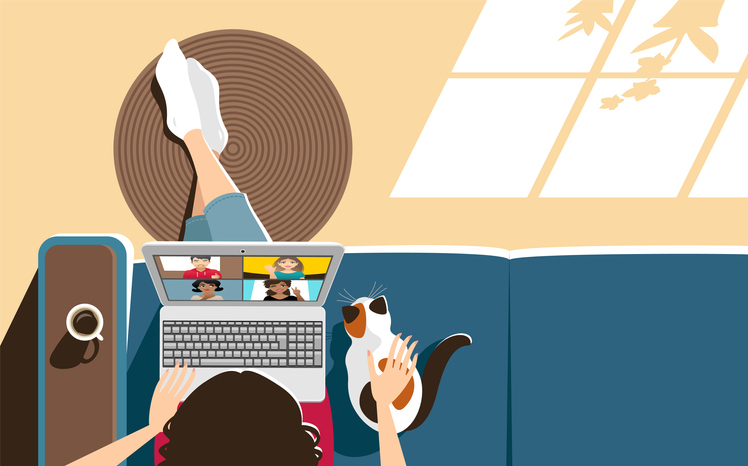How Working From Home Has Changed Employees
They are used to far greater independence. And they may value personal time more.
The employees who return to the office after a year of remote work aren’t the employees their bosses remember.
They have spent over a year adjusting to a radically different rhythm—both in terms of work and their personal lives. They have shifted their working hours, and learned to manage their own tasks without oversight. They may place more value on their family time or personal priorities, and perhaps been forever changed by a loss or health concerns. After a year of working in solitude, many have come to expect more control over how, when and where their work gets done, and to have greater autonomy relative to their managers and organisations.
They may not even feel like they need a whole lot of managing anymore. “Employees are taking on more of the managerial responsibility for their work,” says Holly Birkett, a lecturer at the University of Birmingham in Britain and co-director at the university’s Equal Parenting Project, which surveyed managers and employees during Covid. “They are probably not getting paid any more, but they are feeling more responsibility for getting things done.”
All these changes add up to a challenge for managers, who will need to think differently about how to mentor and coach their team members effectively as they return to the office. Their employees might look like the same people. But rest assured, many aren’t.
Start from scratch
For starters, bosses should consider renewing their relationship with every single employee—even those they’ve managed for years—as if they are starting from scratch.
To that end, they shouldn’t assume what their employees can or can’t do based on what they could or couldn’t do before the pandemic, since they may have acquired new capacities while working from home. Perhaps a junior employee has learned to identify her own tasks and deadlines without the boss laying them out for her; perhaps an arrogant and standoffish sales representative has developed a newly charming phone persona after months of relating long distance or being humbled by pandemic fears.
As a result, it’s best to think about them as fresh hires, asking them how it feels to be back, what they look forward to accomplishing in the months or years ahead, and how they hope to combine home and office time.
Managers might think about treating the initial three to six months after the office reopens as something like a probationary period—not with an eye to firing people, but as a way to assess how employees have grown or changed, and how their own management tactics need to evolve in return.
Taste of independence
Probably the biggest change for managers is that many of their direct reports will have acquired a taste for independence, and a lot less managerial oversight. It isn’t easy to go from a year of freedom to being under the boss’s thumb.
“There is a good chance that those who have been working from home have come to appreciate the autonomy they have gained,” says David Pauleen, a professor in technology management at the School of Management at Massey University in New Zealand, who has studied the work patterns of highly autonomous remote workers. “Some employees might bristle if this management trust in employee capabilities to work more autonomously suddenly ceased.”
Bosses who are nervous about allowing in-office employees the same kind of autonomy they enjoyed at home should pause and remember what they observed during the pandemic. That is, more productive workers. Sarah Forbes, co-director of the Equal Parenting Project, says that “against managers’ expectations, the majority of employees can be trusted to work flexibly, and employees are more productive.” By stepping back, she says, “managers were getting better results.”
Along with acquiring more autonomy over how their work gets done, the past year saw many employees get more control over when their work gets done. Mairead O’Connor, an honorary visiting research fellow at the University of New South Wales Business School, says her research found that during Covid, “management noticed that their workers sought nonstandard work time during the day. It turned out they spent less hours a day working [on weekdays] before 5 p.m., but there was a dramatic increase in the evening and weekends.”
Many employees aren’t going to give up that flexibility easily. Dr. O’Connor recommends that bosses establish core hours during which every worker on a team or project must be online or in the office—and then give employees the flexibility to manage the rest of their schedule.
For managers who are used to tracking their team’s efforts based on a 9-to-5 schedule, this will require a profound shift: managing team members based on progress toward agreed-upon objectives, rather than the number of hours they spend sitting at their desk.
But that doesn’t mean withdrawing supervision. Khim Kelly, a professor of accounting at the University of Central Florida’s Kenneth G. Dixon School of Accounting, found that during Covid, the supervisory mechanisms that are most beneficial to productivity were also the ones that decreased most, including face-to-face meetings and co-worker or third-party evaluations. They were replaced by less effective (but more “remote friendly”) approaches, such as online meetings, email and work logs. For that reason, she says, “managers still need to maintain face-to-face touch points with their employees, as well as reliance on a broader set of data points about an employee’s performance.”
Meetings and socialising
Then there’s the dreaded meeting. Employees have long complained about meeting overload, of course, but the past year took that exhaustion to a whole new level—thanks to the frustrations of virtual meetings plus the reliance on meetings as a way to make up for the loss of informal, spontaneous interactions.
Employees aren’t going to take kindly to going back to the same old same old. The idea that employees should be available to meet anytime between 9 and 5, five days a week, is an outdated way of thinking; so is the idea that employees are cloistered at home, ready to take a call at any time. In the hybrid workplace, employees should be able to keep meetings to the days that they are in the office. That will only work if managers take a team-centric approach to the hybrid workplace, and build a common schedule that brings everyone on the team to the office on the same two or three days each week.
Employees also have gotten used to the idea that meetings are a place for informal check-ins with their colleagues. Over the course of the pandemic, Dr. Birkett says, managers have used “team meetings and communications as a tool to enhance well-being and support employees, rather than purely for operational reasons.” Managers should continue that practice, especially because a year apart may have weakened ties—and trust—among employees.
Dr. Kelly also advises managers to “create opportunities for people to be back in the same space.”
A common schedule is part of that strategy, but managers can do more by encouraging them to maximise their interactions during office days. For instance, if a pre-Covid office was the kind of place where people would get the side eye for spending too much time chit-chatting in the break room, bosses can make an explicit break with that past.
Of course, encouraging social interaction isn’t the same thing as making that interaction mandatory. The past year has allowed introverts to reclaim their freedom from forced, uncomfortable socialising, and given extroverts the opportunity to pursue friendships and activities with colleagues outside of the workplace. Rather than trying to turn back the clock, managers should recognise that some of their employees are going to approach the return to the office like a reunion of long-lost friends, while others are just there to get the job done.
Recognising that different employees have different needs has always been the most important—and the hardest—part about being a manager. That will never be more true than in the coming months. Employees are emerging from the pandemic year as changed, but in different ways. The best managers won’t just recognise that. They’ll also benefit from it.
Reprinted by permission of The Wall Street Journal, Copyright 2021 Dow Jones & Company. Inc. All Rights Reserved Worldwide. Original date of publication: 12, June 2021
 Copyright 2020, Dow Jones & Company, Inc. All Rights Reserved Worldwide. LEARN MORE
Copyright 2020, Dow Jones & Company, Inc. All Rights Reserved Worldwide. LEARN MORE
This stylish family home combines a classic palette and finishes with a flexible floorplan
Just 55 minutes from Sydney, make this your creative getaway located in the majestic Hawkesbury region.
As Paris makes its final preparations for the Olympic games, its residents are busy with their own—packing their suitcases, confirming their reservations, and getting out of town.
Worried about the hordes of crowds and overall chaos the Olympics could bring, Parisians are fleeing the city in droves and inundating resort cities around the country. Hotels and holiday rentals in some of France’s most popular vacation destinations—from the French Riviera in the south to the beaches of Normandy in the north—say they are expecting massive crowds this year in advance of the Olympics. The games will run from July 26-Aug. 1.
“It’s already a major holiday season for us, and beyond that, we have the Olympics,” says Stéphane Personeni, general manager of the Lily of the Valley hotel in Saint Tropez. “People began booking early this year.”
Personeni’s hotel typically has no issues filling its rooms each summer—by May of each year, the luxury hotel typically finds itself completely booked out for the months of July and August. But this year, the 53-room hotel began filling up for summer reservations in February.
“We told our regular guests that everything—hotels, apartments, villas—are going to be hard to find this summer,” Personeni says. His neighbours around Saint Tropez say they’re similarly booked up.
As of March, the online marketplace Gens de Confiance (“Trusted People”), saw a 50% increase in reservations from Parisians seeking vacation rentals outside the capital during the Olympics.
Already, August is a popular vacation time for the French. With a minimum of five weeks of vacation mandated by law, many decide to take the entire month off, renting out villas in beachside destinations for longer periods.
But beyond the typical August travel, the Olympics are having a real impact, says Bertille Marchal, a spokesperson for Gens de Confiance.
“We’ve seen nearly three times more reservations for the dates of the Olympics than the following two weeks,” Marchal says. “The increase is definitely linked to the Olympic Games.”

Getty Images
According to the site, the most sought-out vacation destinations are Morbihan and Loire-Atlantique, a seaside region in the northwest; le Var, a coastal area within the southeast of France along the Côte d’Azur; and the island of Corsica in the Mediterranean.
Meanwhile, the Olympics haven’t necessarily been a boon to foreign tourism in the country. Many tourists who might have otherwise come to France are avoiding it this year in favour of other European capitals. In Paris, demand for stays at high-end hotels has collapsed, with bookings down 50% in July compared to last year, according to UMIH Prestige, which represents hotels charging at least €800 ($865) a night for rooms.
Earlier this year, high-end restaurants and concierges said the Olympics might even be an opportunity to score a hard-get-seat at the city’s fine dining.
In the Occitanie region in southwest France, the overall number of reservations this summer hasn’t changed much from last year, says Vincent Gare, president of the regional tourism committee there.
“But looking further at the numbers, we do see an increase in the clientele coming from the Paris region,” Gare told Le Figaro, noting that the increase in reservations has fallen directly on the dates of the Olympic games.
Michel Barré, a retiree living in Paris’s Le Marais neighbourhood, is one of those opting for the beach rather than the opening ceremony. In January, he booked a stay in Normandy for two weeks.
“Even though it’s a major European capital, Paris is still a small city—it’s a massive effort to host all of these events,” Barré says. “The Olympics are going to be a mess.”
More than anything, he just wants some calm after an event-filled summer in Paris, which just before the Olympics experienced the drama of a snap election called by Macron.
“It’s been a hectic summer here,” he says.

AFP via Getty Images
Parisians—Barré included—feel that the city, by over-catering to its tourists, is driving out many residents.
Parts of the Seine—usually one of the most popular summertime hangout spots —have been closed off for weeks as the city installs bleachers and Olympics signage. In certain neighbourhoods, residents will need to scan a QR code with police to access their own apartments. And from the Olympics to Sept. 8, Paris is nearly doubling the price of transit tickets from €2.15 to €4 per ride.
The city’s clear willingness to capitalise on its tourists has motivated some residents to do the same. In March, the number of active Airbnb listings in Paris reached an all-time high as hosts rushed to list their apartments. Listings grew 40% from the same time last year, according to the company.
With their regular clients taking off, Parisian restaurants and merchants are complaining that business is down.
“Are there any Parisians left in Paris?” Alaine Fontaine, president of the restaurant industry association, told the radio station Franceinfo on Sunday. “For the last three weeks, there haven’t been any here.”
Still, for all the talk of those leaving, there are plenty who have decided to stick around.
Jay Swanson, an American expat and YouTuber, can’t imagine leaving during the Olympics—he secured his tickets to see ping pong and volleyball last year. He’s also less concerned about the crowds and road closures than others, having just put together a series of videos explaining how to navigate Paris during the games.
“It’s been 100 years since the Games came to Paris; when else will we get a chance to host the world like this?” Swanson says. “So many Parisians are leaving and tourism is down, so not only will it be quiet but the only people left will be here for a party.”
This stylish family home combines a classic palette and finishes with a flexible floorplan
Just 55 minutes from Sydney, make this your creative getaway located in the majestic Hawkesbury region.






















